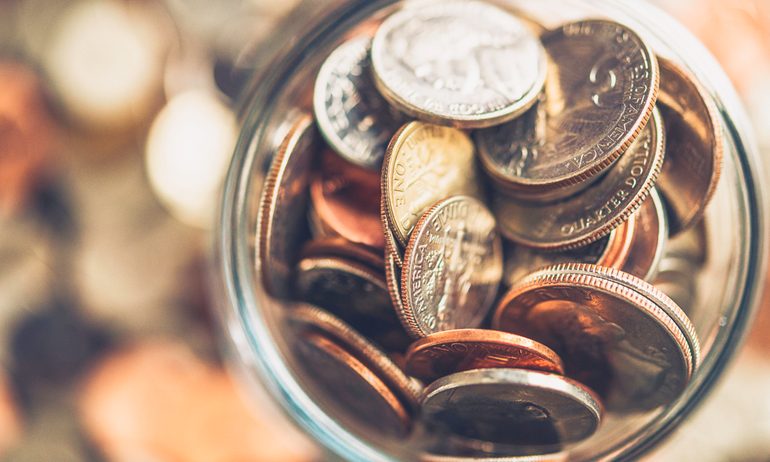What Is a Savings Account?
A savings account is a safe place to store cash and earn interest. Rates on some accounts are above 5%.

Many, or all, of the products featured on this page are from our advertising partners who compensate us when you take certain actions on our website or click to take an action on their website. However, this does not influence our evaluations. Our opinions are our own. Here is a list of our partners and here's how we make money.
Table of Contents
What is a savings account?
A savings account is a deposit account that typically earns interest, is federally insured and held at a financial institution, such as a bank or credit union. With an interest-bearing account, the bank pays you to keep your funds deposited, with annual percentage yields on some accounts reaching over 5%.
As deposit accounts, savings accounts are by definition federally insured up to at least $250,000. This means you won’t lose your money (up to at least $250,000) if the bank fails. (Read more about federal insurance for banks and federal insurance for credit unions).

Member FDIC
Forbright Bank Growth Savings

4.25%
$0

Member FDIC
Axos ONE® Savings

4.66%
$1,500

Member FDIC
Varo Savings Account

5.00%
$0

Member FDIC
E*TRADE Premium Savings

4.00%
$0
Why you need a savings account
Using a savings account creates some distance between everyday spending money that’s kept in your checking account and cash that's needed later, whether for an unexpected emergency, a planned vacation or any other reason. Savings accounts also typically earn more interest than checking accounts.
What you need to know about savings accounts
When you put money in a savings account, the funds are used by the bank to make loans to other customers and businesses. The bank makes money from those loans, so it is able to pay you a little interest in return. But "a little interest" is all too true for many big banks, which often offer low rates of 0.01% APY. In fact, the average national rate for savings accounts is only 0.41%.
Additionally, inflation can chip away at the value of money you have saved over time. You can see how it works with our inflation calculator.
But you can find much higher rates at online banks. Online institutions don't have to support expensive brick-and-mortar branches, enabling many of them to offer APYs that are significantly higher than the national average. And some online accounts offer ATM cards, so you can easily access your funds by visiting a local ATM to make a withdrawal. The accounts also tend to have low deposit minimums and typically don't charge monthly maintenance fees.
Savings accounts with strong APYs can help your money grow
If you put $10,000 in a savings account that earns a 0.01% APY, you’d earn only one dollar after one year. But if you put that same amount of money in a high-yield online savings account that earns a 5% APY, you’d earn more than $500 after a year. That’s a big difference for not much effort.
But you don’t need $10,000 to take advantage of high yields. You can calculate your earnings on any amount using NerdWallet’s savings calculator.
How a savings account works: withdrawal limits
Cash in savings accounts isn't as accessible as in checking accounts. Banks typically limit the number of certain transfers from a savings account — online withdrawals, for example — to six a month. Making additional transfers of these types can result in a fee for each transaction over the limit.
The six-per-month withdrawal cap used to be a federal requirement, but in April 2020, the Federal Reserve removed the limit in response to widespread financial distress caused by the pandemic. As a result, some banks and credit unions relaxed this restriction.
Other types of withdrawals that are less convenient, such as taking money out through a teller or ATM, typically don’t count toward the six-per-month figure. You will want to check with a financial institution to know its specific policies. (Read more in this primer on savings account withdrawal limits.)
However, it’s worth noting that if you tend to withdraw cash for splurge expenses that work against your savings goals, withdrawal limits can be a blessing in disguise. Savings accounts help you store money you don’t need immediately. By avoiding excessive savings withdrawals, you help ensure your money is there when you do need it.
If you need easier access to cash for everyday spending, consider opening a checking account. You can read NerdWallet's list of best checking accounts to find ones that don't have monthly maintenance fees and might even earn interest.
How much to keep in your savings account
You generally want to keep building up your savings account until you reach an amount that could cover three to six months’ worth of living expenses. That can help protect you in case of job loss or another financial emergency.
You can start by making automatic deposits from checking to savings on a regular basis, such as each payday. If you’re able to save $25 a week, for example, it adds up to more than $500 after five months. That could help you pay for an unexpected expense, such as a surprise car repair bill, without going into debt.
If you have the ability, consider using a savings account to save for additional short-term savings goals, such as a car or special vacation. But if you have a cushion and want to save for longer-term goals, such as retirement, consider putting extra funds into investments.
Alternatives to savings accounts
There are other short-term savings options that don't involve investment risk. Here are a few alternatives.
Money market accounts are savings accounts that can have some checking features. For example, they might come with a debit card or the ability to write checks. But as with regular savings accounts, transactions may be limited to a handful per month. You may be charged a fee for each transaction that goes over that limit.
» Learn more about money market accounts
Certificates of deposit, or CDs, hold money for a fixed term, anywhere from a few months to a few years. Generally, the longer the term, the higher the interest rate. Open a CD only with money you won't need immediately, because withdrawing money before the end of the term usually carries a financial penalty of several months’ interest.
» Read up on what CDs are and how they work
Cash management accounts, or CMAs, are cash accounts that have features similar to checking, savings and investments. They are typically offered by nonbank financial service providers like investment firms or robo-advisors. They pay interest and can be especially convenient if you have an investment account with the same provider. (Read more about CMAs)
Where to find the best savings accounts
Start your search by looking at online banks and credit unions. These types of financial institutions, which are heavily featured in NerdWallet's list of best savings accounts, tend to keep fees to a minimum, offer good rates and usually have strong highly-rated mobile apps to help you manage your savings. However, if you plan to do most of your banking at a neighborhood branch, consider accounts at a local credit union.
If you prefer a large bank, review NerdWallet’s list of some of the best national banks.
A good savings account provides a safe place to park your money while it also earns interest. By opening one with strong rates and low fees, and by making regular deposits, you can help make sure you have funds set aside for your savings goals.







